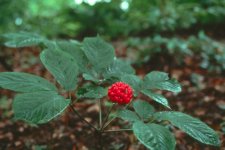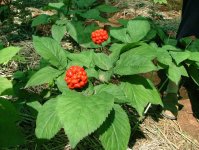Ginseng vulgaris - panax ginseng sa Mey
Family Aralievye - Araliaceae
Botanical characteristics. Perennial herbaceous legendary relict plant. The wild species is listed in the Red Book. Introduced into culture, grown for industrial purposes.
Root branched, pale yellow, resembling a human figure. Stalk straight, single, up to 70 cm tall. Leaves are two-, three- and five-parted. Inflorescence - a simple umbrella of 5-16 flowers with a white corolla and a green cup. Fruits are juicy red with two seeds.
Spread. In the wild it grows in shaded places, in thickets of bushes and ferns.
Used parts of the plant. Medicinal raw materials are the roots, rarely the aboveground part of the plant, collected in the usual way for a third or later year of life. Roots and leaves with flowers are collected during flowering.
Chemical composition. All parts of ginseng contain carbohydrates (fructose, maltose, galactose), organic acids (fumaric, succinic, maleic), essential oil (panacea) in it, alkaloids and other nitrogen-containing compounds; B vitamins, niacin, pantothenic acid, phenol carboxylic acids (salicylic, vanillin, coumaric), heterocyclic compounds (maltol), pigments.
The roots contain carbohydrates and related compounds, essential oil, sesquiterpenoids, triterpenoids, panaxosides, ginsenosides, steroids, nitrogen compounds, vitamins, biotin, nicotinic and folic acids; Polyacetylene compounds, fatty oil (in its composition acids: linoleic, stearic, oleic, palmitic, linolenic), higher fatty acids, alkaloids.
Application. Roots are included in the domestic pharmacopoeia of the 9th-10th editions. They are used as a tonic for hypotension, neurasthenia, overwork, mental illness, for the treatment of poliomyelitis in children and its complications and consequences; With diabetes, cardiovascular diseases, with circulatory failure, impotence and decreased function of the gonads, climacteric effects and concomitant disorders of the autonomic nervous system. They are appointed in the postpartum period, with Botkin's disease, chronic gastritis, to improve visual acuity and hearing, in the complex treatment of eczema, to enhance mental and physical performance.
In the experiment, ginseng preparations have a stimulating effect on the motor functions of the body, increase efficiency and reduce fatigue, improve blood supply to the brain, activate blood formation, have a pronounced antistress property, have an adaptogenic effect, increase immunity, delay the development of atherosclerosis, antitumor effect, inhibit the growth of microbes: staphylococcus , Streptococcus, diphtheria, sarcin, listrell.
Oriental medicine people widely use ginseng preparations for various diseases of the nervous system, anemia, pulmonary tuberculosis, leukemia, stomach, liver, kidney, heart, various skin diseases. It is recommended to take to prolong life and youth.
Preparation. To prepare the tincture take 50 g of the root, chop, pour cold sweet boiling water, after 4 hours the water is poured, and the root is poured with 0.5 liters of 40% alcohol, insist 3 weeks. Take 5-10 ml per reception 30 minutes before meals once a day, preferably in the morning or in the middle of the day.
Contraindications. Widely used ginseng, which has many positive qualities, if used improperly, can cause hypertension, nervousness, insomnia, the appearance of a rash. In this regard, do not exceed the dose, it is better to use ready-made drugs according to the instructions to them and to the doctor's prescription.





Comments
When commenting on, remember that the content and tone of your message can hurt the feelings of real people, show respect and tolerance to your interlocutors even if you do not share their opinion, your behavior in the conditions of freedom of expression and anonymity provided by the Internet, changes Not only virtual, but also the real world. All comments are hidden from the index, spam is controlled.